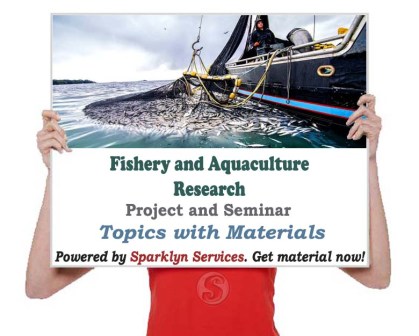1.0 Introduction
Aquaculture in Nigeria is in the developing stage, because it has not been able to meet demand and supple of the ever-increasing human population (Ojutiku, 2008).The development of improved fish seed stocks that can contribute to increased fish production and at the same time ensuring protection of biodiversity and the environment is seen as one of the key solutions to securing future food requirement of the growing world population (Lincoln,1980).Genetics and the successful application of breeding programs in crops and livestock have provided the impetus for the governments it has been acknowledged as the most efficient means of providing protein rich food, income generation and employment opportunities for the populace. (Ojutiku 2008) noted the interest in fish culture is growing very rapidly in Nigeria but the scarcity of fingerlings of widely acceptable species of catfish such as Heterobranchus species (Val. 1840) and Clarias species tend to constitute a major constraint to the rapid development of fish farming in Nigeria. He also mentioned that economically productive aquaculture, is heavily dependent on adequate supply of fish stock to ponds and other culture systems.
One of the methods of improving growth performance of aquaculture species is through biotechnology. This could be through hybridization, genetic engineering and chromosome manipulation. The quest to obtain fast growing species to meet the high demand of fish consumers in the populace has lead fish farmers, to manipulate chromosome of various indigenous culturable fish species(Eyo et al; 2003). Chromosome manipulation is the alteration of chromosome numbers to produce polyploids such as triploid and tetraploid (Lawson and Ishola, 2010). Polyploidy is an occurrence in which gamete and somatic cells possess haploid number of chromosomes. Forms of having 3n chromosomes are triploids; 4n, tetarploids; 5n, pentaploids. The techniques that are used to alter the chromosome number are cold, heat, pressure and chemical shocks. This alteration in chromosome number is often associated with advantageous features such as increased size, hardiness, and resistance to disease (Lawson and Ishola, 2010). Besides, the basic goal governing the technology is to produce sterile fish in order to prevent gamete formation, to produce fast growing fish, to improve carcass quality and to utilize exotic species both in fish farming and fisheries management (Lawson and Ishola. 2010).
Mass production of fry, fingerlings and adult of Clarias gariepinus and Heterobranchus bidorsalis through hypophysation, gynogenesis. Hybridization, and polypoidy had been carried out by many scientist among who are (Gheyas et al; 2001; Herbst, 2002; Eyo et al; 2003, Lawson and Ishola, 2010 and Nwachi, 2012).
In fishes, triploidy and tetarploidy may be currently obtained by shocking newly fertilized eggs shortly after fertilization. Fish eggs do not extrude the second polar body until they are fertilized, because of this, if a newly fertilized egg is shocked, the shock prevents the second polar body from leaving the egg; consequently the fertilized egg will contain three haploid nuclei; one from the egg, one from the sperm, and one from the second polar body (Dunham et al; 2003). These three haploid nuclei will fuse to from a triploid zygote nucleus, which creates a triploid, while four haploid nuclei fuse to form a tetraploid zygote.
Triploid and tetraploids have been created in fishes using shocks (Dunham et al; 2003).( Eyo et al. 2003),induced triploidy in rainbow trout by raising the temperature in which the newly hatched eggs are incoubated at 20°c for 10 minutes beginning from 20-40 minutes after fertilization. Triploids and triploids do not have normal gonadal development (Gheyas et al; 2001) they have much lower gondal somatic indices and they are functionally sterile because they produce aneuploidy gametes. Hence, they might grow faster than diploids as they reach the age of sexual maturity because they may direct energy from reproduction to somatic growth (Gheyas et al;2001).it was further explained that sterility might also suppress some of the other undesirable phenomena (form aquaculture point of view) associated with reproduction such as reduced appetite reduced feed conversion efficiency, deterioration in flesh quality, and post spawning mortality. More consistently than growth rate adult tetraploid and triploids have higher dress-out weights or fillet weights than diploids (Lawson and Ishola, 2010) (Eyo et al.2003) observed that tetraploid and triploid channel catfish have a better dress out percentage than diploid fish as a result of lack of gonadal development.
Thermal treatment involves cold and warm shock which depends on the level of heat or icing involved. Optimal temperature ranges, as well as upper and lower lethal temperatures, vary widely between and among species and are dependent on genetics, developmental stage and thermal histories and (Bitinger et al; 2000; Somero, 2005).
1.1 Justification of the Study
The importance of Clarias spp. Heterbranchus spp. Of catfish being the most cultured and studied aquaculture species, coupled with the high rate of its depletion from the wild stock (as a result of overfishing activity) gingered the present interest to manipulate the chromosome number through cold in order to produce better stock in terms of their growth performance and optimization of triploid of African catfish (Clarias gariepinus) and (Heterobranchus bidorlais). This will improve the aquaculture industry with the provision of species with much better and faster growing stock.
1.2 Aims and Objectives of Study
The study is therefore aimed at;
- Producing triploid and diploid of heteroclarias species,
- Investigating the growth performance of induced triploid (warm and cold shock), compared to their diploid counterpart
- Reporting the effect of cold and warm shock in relation to survival and hatching rate of heteroclarias.




